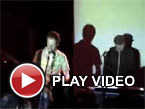Benjamin Finger, "Listen To My Nerves Hum"
 I have been casually following Benjamin Finger's career ever since being completely blindsided by his hallucinatory 2009 masterpiece Woods of Broccoli and I have found it quite perplexing to observe: Broccoli never got even a fraction of the acclaim it deserved and its beat-driven 2011 follow-up (For You, Sleepsleeper) seems to have completely disappeared without a trace.  In a perfect world, this latest effort would redress that inequity (Nerves is Finger's first release on a US label), but Benjamin's current aesthetic has taken quite a curious and challenging turn.
I have been casually following Benjamin Finger's career ever since being completely blindsided by his hallucinatory 2009 masterpiece Woods of Broccoli and I have found it quite perplexing to observe: Broccoli never got even a fraction of the acclaim it deserved and its beat-driven 2011 follow-up (For You, Sleepsleeper) seems to have completely disappeared without a trace.  In a perfect world, this latest effort would redress that inequity (Nerves is Finger's first release on a US label), but Benjamin's current aesthetic has taken quite a curious and challenging turn.
The most succinct and glib way to describe this album is this: Benjamin Finger just bought a piano and seems to be very excited about it.  However, the truth is a lot more complicated and puzzling than that, as Finger has always had a piano and he has employed it quite beautifully in the past as just one small part of his complex, multilayered arsenal.  With Listen To My Nerves Hum though, Benjamin has essentially jettisoned everything else from his palette except for some muted field recordings.  Also, on a deeper level, he seems to have additionally abandoned almost everything he knows about music: on Beneva vs Clark Nova's Sombunall, he showed he could craft great electronic pop songs, then on Woods of Broccoli, he demonstrated that he was even more adept at fragile, sublimely beautiful psychedelia.  With Nerves, he often sounds like an outsider artist trying to channel Erik Satie though real-time improvisations.
While that admittedly seems like a very self-defeating move, it is also a very daring and noble one: all artifice and processing has been stripped away to leave only music at its most naked and organic.  I doubt I ever would have given Nerves a second listen if I had not already been confident that Finger knew what he was doing, but there is definitely something here–it just takes some significant attention to appreciate it, as the album's quiet, unique beauty gradually revealed itself to me more and more with repeat listens.
Most of the best parts occur when well-chosen field recordings unexpectedly make their way into the foreground, like they do in album highlight "Ãno Nuevo Acid Crackers," where the melancholy plinking piano motif is gradually forced to share the stage with the celebratory sounds of a fireworks display.  Most of the time, however, the field recordings are used in much more subtle fashion, lending just a hint of cinematic otherness to Finger's playing (like the footsteps, echoing voices, and crackling French radio broadcast beneath "Das Paris Des Second Empire Benjamin").  Also, the sound of Benjamin's piano is in itself somewhat mesmerizing, as it seems close mic'd in a way that renders every little oscillation and nuance of decay audible.
All of that makes Listen To My Nerves Hum an extremely difficult album to formulate a clear opinion on.  As a listener, I found the album to be a bit exasperatingly one-dimensional and simplistic, as it feels like a series of sketch-like, lo-fi improvisations.  My frustration was amplified by the fact that several individual pieces were quite good and would have been much more striking and emotionally resonant if they had been transitioned to in a more effective and dynamically/texturally varied way–an entire album of monochromatic, minimalist piano tinkling invariably makes my ears very sleepy.  However, as a Benjamin Finger fan, this album is kind of exciting: it is ambitiously uncharacteristic and unexpected, deliciously cryptic, and leaves me with absolutely no idea where he might go next.  Also, the music itself is just one facet of the release-if I had been one of the 70 people to get the limited edition CD version, I would probably be hailing Nerves as an unqualified masterpiece, as it might possibly have the coolest packaging that I have ever seen (it folds out into a strange extinct bird mobile made from antique piano innards).  Which, I suppose, ultimately makes Listen To My Nerves Hum a great installation rather than just a likable, but flawed, album.
(Note: This is a review of the marginally less cool-looking vinyl version, as the hopelessly sold-out "bird mobile" version includes five additional songs)
 



